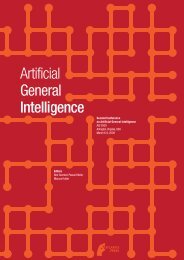Algorithmic Learning Theory - of Marcus Hutter
Algorithmic Learning Theory - of Marcus Hutter
Algorithmic Learning Theory - of Marcus Hutter
You also want an ePaper? Increase the reach of your titles
YUMPU automatically turns print PDFs into web optimized ePapers that Google loves.
Editors’ Introduction 5<br />
Jean-Yves Audibert, Rémi Munos and Csaba Szepesvári deal with the stochastic<br />
multi-armed bandit setting. They study an Upper Confidence Bound algorithm<br />
that takes into account the empirical variance <strong>of</strong> the different arms. They<br />
give an upper bound on the expected regret <strong>of</strong> the algorithm, and also analyze<br />
the concentration <strong>of</strong> the regret; this risk analysis is <strong>of</strong> interest since it is clearly<br />
useful to know how likely the algorithm is to have regret much higher than its<br />
expected value. The risk analysis reveals some unexpected trade<strong>of</strong>fs between<br />
logarithmic expected regret and concentration <strong>of</strong> regret.<br />
Jussi Kujala and Tapio Elomaa also consider a multi-armed bandit setting.<br />
They show that the “Follow the Perturbed Leader” technique can be used to<br />
obtain strong regret bounds (which hold against the best choice <strong>of</strong> a fixed lever<br />
in hindsight) against adaptive adversaries in this setting. This extends previous<br />
results for FPL’s performance against non-adaptive adversaries in this setting.<br />
Vovk’s Aggregating Algorithm is a method <strong>of</strong> combining hypothesis predictors<br />
from a pool <strong>of</strong> candidates. Steven Busuttil and Yuri Kalnishkan show how<br />
Vovk’s Aggregating Algorithm (AA) can be applied to online linear regression in<br />
a setting where the target predictor may change with time. Previous work had<br />
only used the Aggregating Algorithm in a static setting; the paper thus sheds<br />
new light on the methods that can be used to effectively perform regression with<br />
a changing target. Busuttil and Kalnishkan also analyze a kernel version <strong>of</strong> the<br />
algorithm and prove bounds on its square loss.<br />
Unsupervised <strong>Learning</strong>. Many <strong>of</strong> the standard problems and frameworks in<br />
learning theory fall under the category <strong>of</strong> “supervised learning” in that learning<br />
is done from labeled data. In contrast, in unsupervised learning there are no<br />
labels provided for data points; the goal, roughly speaking, is to infer some<br />
underlying structure from the unlabeled data points that are received. Typically<br />
this means clustering the unlabeled data points or learning something about a<br />
probability distribution from which the points were obtained.<br />
Markus Maier, Matthias Hein, and Ulrike von Luxburg study a scenario in<br />
which a learning algorithm receives a sample <strong>of</strong> points from an unknown distribution<br />
which contains a number <strong>of</strong> distinct clusters. The goal in this setting is<br />
to construct a “neighborhood graph” from the sample, such that the connected<br />
component structure <strong>of</strong> the graph mirrors the cluster ancestry <strong>of</strong> the sample<br />
points. They prove bounds on the performance <strong>of</strong> the k-nearest neighbor algorithm<br />
for this problem and also give some supporting experimental results.<br />
Markus received the E. M. Gold Award for this paper, as the program committee<br />
felt that it was the most outstanding contribution to ALT 2007 which was<br />
co-authored by a student.<br />
Kevin Chang considers an unsupervised learning scenario in which a learner<br />
is given access to a sequence <strong>of</strong> samples drawn from a mixture <strong>of</strong> uniform distributions<br />
over rectangles in d-dimensional Euclidean space. He gives a streaming<br />
algorithm which makes only a small number <strong>of</strong> passes over such a sequence, uses<br />
a small amount <strong>of</strong> memory, and constructs a high-accuracy (in terms <strong>of</strong> statistical<br />
distance) hypothesis density function for the mixture. A notable feature <strong>of</strong><br />
the algorithm is that it can handle samples from the mixture that are presented













